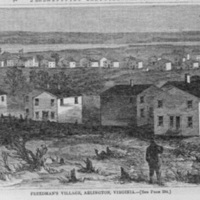Suburban Ideals in Arlington
Since its earliest suburban development in the 1860s, Arlington was made up of diverse neighborhoods, each with divergent, competing visions for the area’s future. The diverse communities tracked with then-contemporary ideas about suburban development. These ideals changed over time, from isolated suburban village communities dotted across the landscape, to one contiguous, dense suburban environment of interconnected communities, from exclusively single family homes, to environments that included row homes and apartment complexes. These ideals were sometimes in conflict with one another as Arlingtonians negotiated what kind of environment made an area a good place to live.
Arlington’s first pre-planned suburban community was the African American community of Freedman’s Village. The Village was opened in 1863 by the War Department for formerly enslaved individuals and families. The Village was a pre-planned community with houses, roads, and institutions as a physical representation of federal goals of moral uplift for the formerly enslaved population. The community featured 100 white washed, one-and-a-half story duplexes in a pared- down version of the Classical Revival style. Initially chosen by the War Department, this housing type was embraced by black Arlingtonians who recreated this style when building homes beyond the Village.
Electric railways helped to encourage the development of suburban neighborhoods in Arlington. Arlington’s developers pushed for a suburban vision consistent with the idealized street car and picture window suburbs in neighborhoods including Lyon Park, Maywood, and Corbett. The homes in these communities were all constructed in centrally planned developments. Arlington was a part of a national trend away from piecemeal, individual home building and toward large, centrally planned community developments. These communities were pre-planned on grid patterns primarily by developers and focused on symmetry, aesthetics, order, and the use of green space. One reason for this focus on preplanned developments was the City Beautiful Movement – an aesthetic, social, and political movement popular amongst the upper and middle class. Developers hoped to use aesthetics and connections to environmentalism in building to encourage order, symmetry, and harmony in life, with the aim of refashioning citizens' lives to make them engaged and well-rounded through changes in landscape design.
Lyon Village was constructed in 1923 with standardized, pre-platted lots, each with 50 foot frontages, and included a park and community center for community residents. Arlington's subdivisions were becoming increasingly standardized at this time. Many of these new communities found success in seeking out members of the new middle class, including builders, bookkeepers, lawyers, and teachers. The homes developed in Lyon Village were professionally built, single-family, large, brick homes restricted to the Classic, Colonial, Mission, or Tudor revival styles. These homes also tracked more closely with national trends.
This housing expansion required serious development of Arlington’s road networks. While Arlington’s suburbs initially developed along rail lines, local community advertisements highlighted road over rail access beginning in the early 1920s. By the 1930s the personal car dominated the suburban landscape. In advertisements for the neighborhood, the Village highlighted the community’s road connections to Washington, just fifteen minutes by car across the upcoming Memorial Bridge.
From 1930 to 1950 Arlington was the fastest growing county in the United States. And the changes in the built environment associated with this boom seemed as sharp and they were sudden. Each of Arlington’s existing neighborhoods expanded, subdividing land and removing green space to allow for more residents. In addition to expansion of existing neighborhoods, seven new communities were constructed – Arlington Forest, Dominion Hills, Fairlington, Madison Manor, Tara Leeway, Williamsburg, Westover, and the Columbia Forest neighborhood, pictured here. The neighborhood was constructed in 1941 by the Army Corp of Engineers, filled with simple brick two-story box homes with little landscape and community planning.
But despite the building boom, single family housing alone was not sufficient to meet Arlington’s growing housing needs. Some of Arlington’s neighborhoods introduced garden style apartments for the first time. In the 1930s Arlingtonians joined the ranks of builders and developers across the U.S. looking to European models of housing and planning to find solutions for the shortage in housing that plagued the country during and after the Great Depression. These multi-family units were centrally planned to help decrease waste and sprawl while providing the most amenities at the best cost. The first large scale garden apartment complex built in Arlington, indeed one of the first complexes of its kind in the nation, was 1935’s Colonial Villages by Gustave Ring. The first stage of construction began with 276 units on twenty-five acres of land off of Wilson Boulevard between Rosslyn and Court House. Despite the huge number of buildings, structures only comprised about 18% of the total land in the Colonial Village complex. Landscaping and comprehensive design was an important element of the garden apartment movement and the design of Colonial Village.
From the late-1930s to the early 1950s, the core years of Arlington’s suburban boom, garden and low-rise apartment complexes became a dominant home and architectural type in Arlington until a total of 176 individual apartment buildings existed throughout the county. Despite their need, popularity, architectural praise, and racial policies which fit local customs, many local Arlingtonians resisted garden apartment communities.




